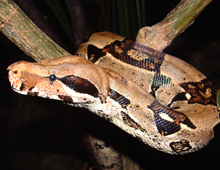Description: Orton’s boa is a subspecies of Boa constrictor. There are several subspecies that are identified mainly by their range, rather than their appearance, but form, size and color does occur within regions. Boas have diamond, oval and/ or narrow rectangular-shaped patterns of brownish- red with black outlines. The markings are on a background of cream, pale tan or gray. Those boas referred to as “red-tails” have red colorations on the tail.
Size: Adult average size is 6 -10 feet (1.5-2.4 m) long; weight is less than 60 pounds (27 kg). Males are usually smaller than females.
Behavior: These snakes are solitary and nocturnal. If night temperatures are low, they may bask during the day. Their prehensile tails are used for attaching to branches; they become more terrestrial as they grow in size and age. Even though they are non-venomous, they will strike and can deliver a painful bite if threatened. They are particularly unpredictable when shedding (vision is not good at this time).
Diet: Usual food is large lizards, birds (such as antbirds) and small mammals (squirrels, opossums, spiny rats, pacas, agoutis and mice). Boas kill by suffocating their prey by constricting as its coils around the animal.
Senses: By flicking their tongues, the chemosensory organ in the top of their mouths, give them chemical cues about their surroundings. Their vision is good (except when shedding). They are able to sense terrestrial and sound vibrations.
Communication: Boas mainly communicate by use of chemosensory and visual signals
Reproduction: Males are polygynous, mating with several mate with multiple females; females may mate with more than one male in a season. Only about 50 percent of adult females will reproduce annually. Fertilization is internal; Boa constrictors are ovoviviparous; embryos develop within their mothers’ bodies. The young are born live and are independent soon after birth.
Habitat/range: Boa constrictors are found in various habitats, primarily in rainforest edges or clearings but can also be found in dry tropical forests, grasslands, woodlands and semi-desert areas. The Boa constrictor ortoni is a Peruvian coastal boa.
Status: Not listed on IUCN Red List; CITES, Appendix II.



